Question from Fabi R.:
Dear Geek,
I stumbled onto patent #1120656 the other day, and it looks like the pushpin (thumbtack) we buy & use today. Do you know if this was the original pushpin? And could you, anyway, tell me if not which one was and how did they came up with the idea?
Thanks, Geek!
Sincerely,
Fabi

Category: Historic Inventions
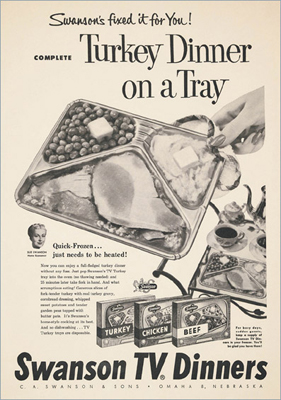 When Swanson introduced the TV dinner in 1954, it was an instant success. The frozen meal fit in perfectly with the nation’s obsession with prepackaged, convenience foods and a growing love of the television. At a price of 98 cents, the first meal sold was basically a Thanksgiving dinner with turkey, cornbread dressing, peas and sweet potatoes. Swanson hoped to sell about five thousand dinners the first year. Instead, sales hit more than 10 million.
When Swanson introduced the TV dinner in 1954, it was an instant success. The frozen meal fit in perfectly with the nation’s obsession with prepackaged, convenience foods and a growing love of the television. At a price of 98 cents, the first meal sold was basically a Thanksgiving dinner with turkey, cornbread dressing, peas and sweet potatoes. Swanson hoped to sell about five thousand dinners the first year. Instead, sales hit more than 10 million.
Although there were many frozen prepackaged meals before the Swanson’s TV dinner, none were as successful as Swanson’s in its aluminum three-compartment tray ready to be cooked at 425 °F for 25 minutes. Like many food inventions, the actual inventor of the Swanson’s TV Dinner is questionable. Gerry Thomas, an executive at Swanson, claimed he invented the frozen meal. But this claim has been disputed in recent years by other Swanson employees and Swanson family heirs. They claim the product was invented by the Swanson brothers, Clarke and Gilbert.
There are many accounts as to how Thomas formulated the idea for the TV dinner. In one story, the dinner was produced to use a large surplus of frozen turkeys which resulted from poor Thanksgiving sales. Another story is that inspiration for the meal came aboard a Pan Am Airways flight. The three-compartment aluminum tray was fashioned after the a tray in which a in-flight meal was served. Supposedly, the name for the meal did not come from the idea of eating the dinner in front of the television. Thomas designed the packing to resemble the front of a TV set with the inset screen and the rotary knobs. Continue reading “TV Dinner Controversy…”
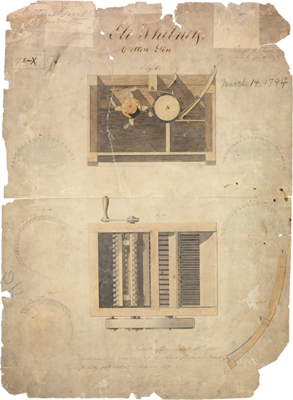 An invention can be so valuable as to be worthless to the inventor. Eli Whitney came to this conclusion because of the financial failure that was the cotton gin. Whitney gained fame and notoriety from his invention but did not gain the wealth he had anticipated.
An invention can be so valuable as to be worthless to the inventor. Eli Whitney came to this conclusion because of the financial failure that was the cotton gin. Whitney gained fame and notoriety from his invention but did not gain the wealth he had anticipated.
The cotton gin is a mechanical device that removes seeds from cotton. Before the invention of the gin, seeds had to be removed by hand. The cotton gin was a wooden cylinder with wire teeth. The teeth grabbed the cotton fibers and pushed them through a grate. The seeds were too large to fit through the grate so they were pulled away from the fibers. Whitney’s cotton gin could clean about 55 pounds of cotton a day.
The invention of the cotton gin changed the cotton industry in the United States. Whitney gave a one-hour demonstration of his new invention and farmers were ecstatic. They could now plant green seed cotton and remove the seeds much quicker and effectively.
Whitney did receive a patent for his cotton gin on March 14, 1794. This patent would later be numbered as X72. Whitney and his partner, Phineas Miller, did not actually intend to sell their product. They were planning to charge farmers for the service of cleaning the cotton. Their large price, two-fifths of a farmers profit, paid in cotton was the beginning of their financial problems.
Question from Gary L.:
I think the drive-through is one of the best inventions ever. I love that I can get food and coffee without ever having to get out of my car. Who should I thank for this wonderful convenience?
Hello Gary,
The first drive-up window was actually not at a fast food restaurant. The first window was added to the City Center Bank in Kansas City, Missouri. Bank president. R. Crosby Kemper opened this window in 1928.
The idea of a drive-through window was not translated to a restaurant until twenty years later. In-n-Out Burger claims that they built the first drive-through restaurant in 1948. The restaurant, in Baldwin Park, CA had an intercom system so customers could order without ever getting out of their cars.
Today, drive-through windows can be found everywhere from restaurants, coffee shops and banks to drug stores, funeral homes and wedding chapels. Next time, you enjoy the convenience of the drive-through you should thank Harry and Esther Snyder, the founders of In-n-Out Burger.
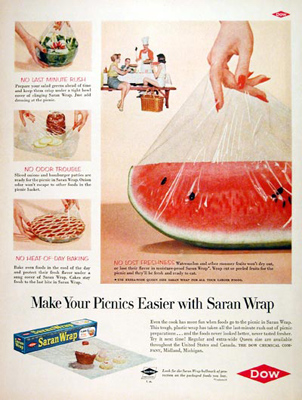 Saran wrap is another product which can be added to the list of accidental inventions. Ralph Wiley was not even working as a scientist when he discovered the substance that would become Saran wrap.
Saran wrap is another product which can be added to the list of accidental inventions. Ralph Wiley was not even working as a scientist when he discovered the substance that would become Saran wrap.
In 1933, Wiley was working in a laboratory at Dow Chemical cleaning glassware when he found polyvinylidene chloride, the chemical that would later become Saran Wrap. He came across the substance in a vial that he could not scrub clean. Wiley called this chemical “eonite” after a material in the Little Orphan Annie comic strip.
Wiley applied for a patent on July 1, 1936. He was granted US Patent 2,160,931 on June 6, 1939 for
Co-Polymerization Products.
Researchers at Dow turned eonite into a greasy, dark green film. The product was not originally used to wrap food. The substance was used first by the military to protect fighter plants against salty sea spray and then carmakers used it for upholstery. It was not until Dow created a version without the smell and green color that it was used for food protection. Continue reading “Yes, Saran Wrap Was An Accident Too…”
Question from Carrie:
I was listening to Jimmy Buffet’s song “This Hotel Room” and one of the lines is- “Feel alright, feel alright. Magic Fingers makes you feel alright.” I remember hearing that Magic Fingers was popular in motels a while back. Who invented it?
Hey Carrie,
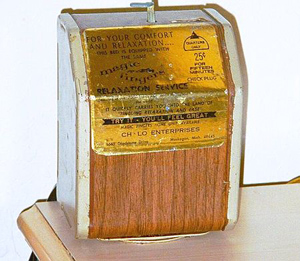 John Houghtaling invented Magic Fingers in his New Jersey Home in 1958. He received patent 3,035,572 for a vibrator on May 22, 1962.
John Houghtaling invented Magic Fingers in his New Jersey Home in 1958. He received patent 3,035,572 for a vibrator on May 22, 1962.
Magic Fingers was a vibrating bed relaxation system found in many motels during the 1960s and ’70s. It was installed onto millions of beds and in exchange for a quarter, the bed would provide 15 minutes of vibrating relaxation. The device was marked by a label reading; “Magic Fingers quickly carries you into the land of tingling relaxation and ease.”
Houghtaling was a salesman for a company that sold vibrating beds. The bed and the vibrating motor were sold together as a single item. While fixing a broken unit, Houghtaling realized that the vibrating motor was the most essential element and not the bed itself. He wanted to design a vibrating unit that could be attached to the box spring of any bed. He tested about 300 motors before finding the right combination that was light in weight and made the bed vibrate at a comfortable frequency.
At the height of its’ popularity, Magic Fingers collected about $6,000 to $7,000 a month in quarters.
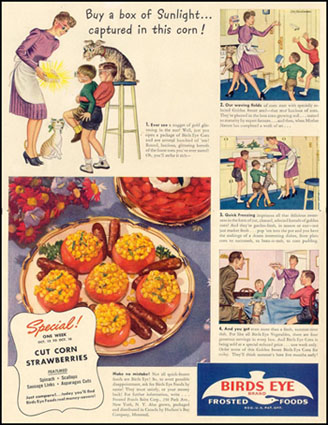 As a young adult, struggling to financially support himself through Amherst College by catching and selling frogs to the Bronx Zoo, Clarence Birdseye would later come into a great fortune within the food industry and be named ‘The Father of Frozen Food.’
As a young adult, struggling to financially support himself through Amherst College by catching and selling frogs to the Bronx Zoo, Clarence Birdseye would later come into a great fortune within the food industry and be named ‘The Father of Frozen Food.’
In 1912, Birdseye went on a fur-trading expedition to the Canadian province of Labrador when he realized that there was a fortune to be made in breeding and trapping foxes. He did just that for the next five years. He also did a fair amount of fur re-sale. Food supply in secluded parts of Labrador were little, so he ate things such as blackbirds, whale, lynx, lizards, starlings, alligator, beaver tail and skunk.
Birdseye was taught how to ice fish under thick ice by the native Inuit people. Once caught, he realized the fish froze almost instantly and when thawed, tasted fresh. Birdseye saw the preservative effects of extremely cold temperatures on fresh fish. He realized that this ‘fast freezing’ method could develop into a great way for people to have access to fresh food all year-round. Continue reading “The Father of Frozen Food”
Question from Felix:
Hey Invention Geek,
Is there a patent for the MRI machine? If so, who holds the patent?
Thanks for your question, Felix!
The short answer is: yes, there are, in fact, a few of patents associated with the development of the modern MRI.
The slightly longer answer includes stories of betrayal, intrigue, and full page ads in the New York Times.
First of all, Raymond Damadian is widely credited with the initial discovery of Magnetic Resonance Imaging (MRI).
After exposing tissue samples to nuclear magnetic resonance, Damadian observed a difference between tissue in a cancerous tumor and healthy tissue. He published an article in 1971 in the journal, Science, about his findings. In collaboration with other doctors, the first MRI for a full body scan was built in 1977. Damadian named it the “Indomitable,” because of the seven years of complex work needed to finish the project.
He obtained US patent 3,789,832 for the MRI machine, called an “apparatus and method for detecting cancer in tissue,” in February of 1974 and was eventually inducted into the National Inventor’s Hall of Fame for this achievement in 1989.
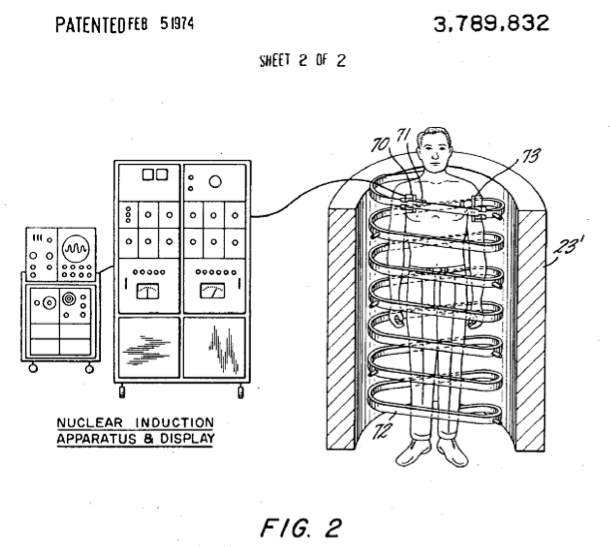
An image from Damadian's MRI Patent, issued Feb 5, 1974.
Now, while credit for the original MRI scanning machine goes to Dr. Damadian, credit for the development and refinement of magnetic imaging — which is what helps the machine do what it does as well as it does it — belongs mainly to chemist Dr. Paul Lauterbur. Damadian’s original patent had included the use of nuclear magnetic resonance (NMR) for diagnostic imaging, as it ahd been discovered a few decades earlier, but it turned out to be fairly inaccurate and was deemed unsuitable for diagnostic purposes.
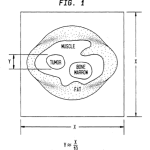
Lauterbur's 1992 patent on NMR magnetic imaging.
Lauterbur’s work developing the use of NMR for magnetic imaging was crucial in the ultimate success of the MRI Machine as a diagnostic tool. The doctor worked for decades to improve the accuracy and reliability of the imaging process. In 1992, he was awarded patent 5081992 for a “method for calculating localized magnetic resonance spectra.”
In 2003, Dr. Lauterbur and British chemist Peter Mansfield were jointly awarded the Nobel Prize for their work in the field.
But Dr. Damadian was not to be forgotten. After Lauterbur was awarded the Nobel prize in 2003, Damadian (or friends, as some stories have it) took out full page ads in the most popular newsparers denouncing Lauterbur’s win and demanding reconsideration. While there is no appeals or recall process for a Nobel Prize, Damadian did receive additional recognition in 2004 when he was awarded a Bower Award for scientific excellence by the Franklin Institute.
Dr. Lauterbur was finally given a well-earned place in the National Inventor’s Hall of Fame in 2007.
Both men contributed greatly to the advancement of modern medical diagnostic technology as we know it.
Have Your Own Question for the Invention Geek?
Ask away! If we choose to publish your answer online, you’ll get a free patent mug. Submit your question now!
A period of time where people depended on a candle flame as a means of a portable device to help see in the dark came to an end with the invention of the flashlight. However, the invention of the flashlight did not occur until later in the 19th century because it depended on the inventions of the electric light and battery.
Joshua L. Cowen was the original owner of the American Eveready Battery Company and designed a safety fuse to ignite photographic flash powder. This was the precursor to the modern flash bulb. However, the invention did not see much success as Cowen had hoped for photographers. The U.S. Navy bought the fuses and used them with underwater explosives.
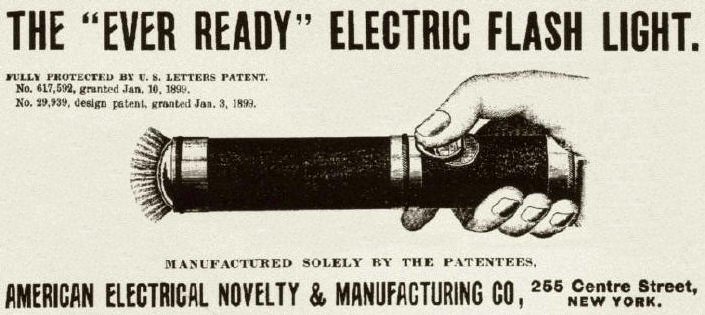 Later, Cowen came up with the idea of decorative lighting for a flower pot. This light up device was composed of a metal tube, light bulb and ran on a dry cell battery. This garden decoration was also a failure.
Later, Cowen came up with the idea of decorative lighting for a flower pot. This light up device was composed of a metal tube, light bulb and ran on a dry cell battery. This garden decoration was also a failure.
In 1896, Cowen sold his company, ideas and patents to Conrad Hubert to become a full-time inventor. Cowen went on to pursue his passion for trains and created toys and a new company; Lionel Model Trains.
Hubert was a Russian immigrant who moved to the United States in 1891. In Russia, Hubert had a reputation as a great businessman. However, because of the Russian persecution of Jews, Hubert chose to move to the United States and arrived at Ellis Island in 1891. He changed his name to Conrad Hubert from his birth name, Akiba Horowitz. Exercising his business skills, Hubert opened a cigar shop in New York City. He also tried working within several other businesses including; restaurant, a boarding house, a milk wagon route, a jewelry store, a farm and a novelty shop. The novelty shop would become Hubert’s most successful business. Continue reading “Let There Be Light! – Invention of the Flashlight”
Question from Douglas:
I use a ballpoint pen nearly everyday, who invented it?
Douglas,
The first ballpoint pen patent, 392,046, was issued to John Loud on October 30, 1888. Loud was a leather tanner and needed a writing device to assist him with marking leather and cloth. Regular fountain pens were unable to perform the tasks Loud needed. The new ballpoint pen worked well on tough surfaces, but was too rough for use of paper. The pen was never commercially produced.
View Loud’s patent here.
Irritated with how often he had to fill his fountain pen with ink, László Bíró, wanted to invent a better writing product. Bíró realized the ink used for newspaper printing dried quickly without smudging. He wanted to create a writing device that would dispense ink with the same qualities as the newspaper ink. László and Georg Bíró created the first commercial ballpoint pen. The brothers filed for a British patent on June 15, 1938. They also filed and received US patent 2,400,679 on May 21, 1946. The pen had a few kinks. However, thanks to a creative marketing strategy, the ballpoint pens were popular, especially among the British Royal Air Force.
View Bíró’s patent here.
